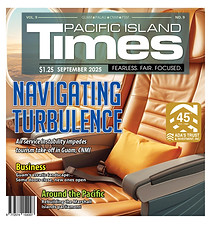Yap defense projects form US power projection in Micronesia
- Admin

- Jul 30
- 3 min read
Updated: Jul 30
DOD proposes to deploy fighter aircraft to the island state for twice-a-year annual military exercises

By Mar-Vic Cagurangan
The U.S. Department of Defense has released details of its proposed airport and seaport projects on Yap, which would facilitate military deployment and project power posture in the Federated States of Micronesia.
While the defense plan does not include permanent basing on the island state, the proposed projects would pave the way for smooth entry of U.S. military aircraft and vessels, including those owned by allied countries.
“Once airport improvements are complete, training is expected to include
several weekly landings of cargo and fighter aircraft with associated support personnel and approximately two military exercises per year of up to 14 days
each, involving deployment of approximately 100 personnel to Yap,” the DOD states in the notice of intent to prepare an environmental impact statement.
“The purpose of the proposed action at the Yap airport is to enhance the ability of the Department of the Air Force and Department of the Navy to conduct forward presence, contingency response and military readiness activities in the FSM,” the notice reads.
Read related stories
The U.S. Air Force is investing $400 million in Yap for the airport upgrade project.
Earlier this year, Defense Secretary Pete Hegseth announced the Pentagon’s plan to pour as much as $2 billion into the FSM and build more projects to enable U.S. forces to operate in the Pacific island nation.
The U.S. is beefing up its presence in the Indo-Pacific region to counter China’s military expansion.
During a bilateral meeting in March, the U.S. and the FSM reached a mutual understanding to proceed with the construction of previously authorized U.S.-funded infrastructure projects in Yap.
The FSM has diplomatic ties with China, but the Compact of Free Association grants the U.S. exclusive rights to use the FSM land, water and airspace for military purposes.
The strategic denial rights under the treaty are intended to curtail any attempt by the communist regime to advance military presence in the Pacific nation.
The DOD said the proposed projects are consistent with “U.S. defense obligations” under the compact, which pledges the FSM $3.3 billion out of the $7.1 billion 20-year economic package shared with Palau and the Marshal Islands.

At the Yap airport, the DOD plans to “construct and operate facilities and
infrastructure to support military readiness activities involving fighter, cargo tanker and other aircraft types.”
According to the notice, planned improvements include airfield infrastructure within an approximately 447-acre project area, including runway extensions, aircraft parking apron, parallel taxiway, roadway
improvements and realignments, fuel storage, support buildings, ancillary
facilities and staging and laydown areas.
“No permanent personnel, full-time aircraft basing, munitions use, or airspace modifications are included in the proposed action,” the notice states.

“Site selection at the existing Yap airport was based on its existing utilities, airspace protections, logistical
advantages and desire to minimize land use consistent with the COFA.
However, the DOD said additional land may be
temporarily needed to support staging and laydown
and worker lodging.
“The improvements would enhance both military readiness and civilian airport capacity and potential by supporting aviation services and safety,” the DOD said.
For the seaport, the DOD proposes to upgrade Tamil Harbor facilities “to support dual-use operations
and occasional U.S. and allied vessel mooring.”
Work includes wharf and bulkhead reconstruction, harbor and channel dredging, and replacement of aids to navigation.
“The proposed action is needed to address current limitations to safe and efficient multi-user activities at the airport and seaport, which constrain the U.S.’s ability to meet its defense obligations under the COFA and the ability of DOD to meet mission requirements in the Indo-Pacific region,” the DOD said.
Reinforcing Yap's airport capacity aligns with the U.S. Air Force's "agile combat employment" strategy to boost air forces' combat power and survivability by operating from dispersed, temporary locations, rather than relying solely on main operating bases.
Currently, Guam and Hawaii are the main launch pads for the Pacific Air Forces.
“Without the proposed improvements, operational effectiveness and support for humanitarian and contingency operations would remain limited and
operations at the Yap airport would continue to fail to meet FAA safety standards," the DOD said.
In May, U.S. and FSM officials signed an agreement that will facilitate defense construction and other related projects in Yap.
The "operational control letter" grants the Yap government some authority “to work together with the Department of Defense to allow some construction efforts to happen.”

Subscribe to
our digital
monthly edition






